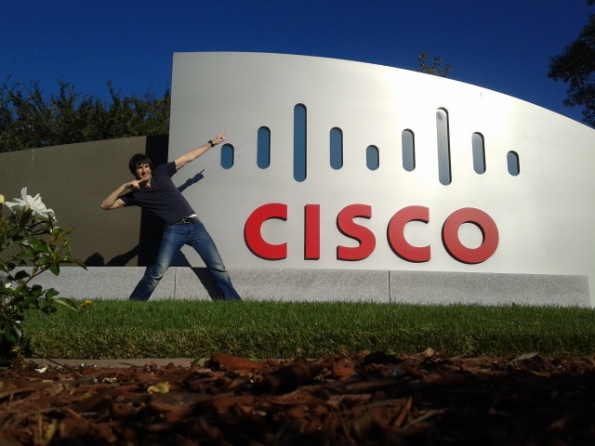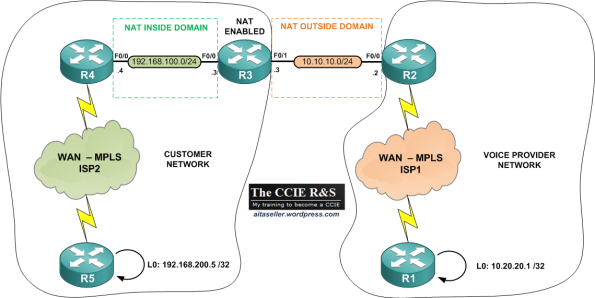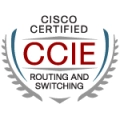CCIE R&S V4.0 Troubleshooting GNS3 Lab 1
Hi Everyone,
It is my pleasure to announce that I am publishing the first CCIE R&S V4.0 GNS3 TS lab in this post. I would first like to apologize for the delay. I know that many people have been waiting for this, so here you are.
CCIE R&S Troubleshooting GNS3 Labs soon available
I will soon publish 5 Troubleshooting CCIE R&S Labs based on INE GNS3 Lab1 topology. I have made these labs with one of my friend when training for the CCIE R&S troubleshooting section. Each lab has 9 tickets and is a bit harder than the real lab exam.
As the topology is based on GNS3 with around 30 routers you will need a powerful machine to run GNS3 on it. An alternative will be to use Amazon Web services and build your own online server in order to run GNS3 on it. We have used a High-Memory Quadruple Extra Large Instance which is maybe a bit overkilled but it was working really well.
Stay tuned.
Thanks for reading,
Laurent
My CCIE plaque has arrived
Yesterday I received my CCIE plaque almost two months after passing the CCIE R&S Lab. The quality is good and it is quite heavy. Here is a picture of it:
My next post will be dedicated to which training material I have used from INE as well as which training strategy I have used to pass the CCIE R&S Lab.
Thanks for reading.
/Laurent
The story of my third attempt
As you may already know, I passed the CCIE R&S lab on the 12 of March 2013. I wanted to write about my story just after I passed the exam but I really needed a break so here is the story of my third attempt; the last and the successful one.
I arrived in Brussels one day before my exam, on the 11th of Mach, it was a Monday. I needed to take 2 planes to get there, one from Denmark to Frankfurt and then one from Frankfurt to Brussels. I didn’t have any delay on the first flight but things got worse in Frankfurt because it started snowing a lot. My second flight was 2 hours late and I arrived quite late in Brussels, around 20:00. I was staying at the same Hotel (NH hotel, besides Cisco). When I got in my room, I was feeling alright until I got to bed. On my second attempt, I was really nervous during the night and I only managed to sleep around 1 hour. This time it was better but it was really hard to fall asleep; however I slept better than on my second attempt. I woke up at 07:00 and went for breakfast. I tried to eat not too much but just enough to get the sufficient energy for the exam. I was quite nervous but for sure less than on my second attempt. At 07:45, I walked to the Cisco building and there was so much snow outside. It has been snowing all the night. I heard that all flights in Frankfurt were cancelled this day so I was lucky to take the exam that day and not on Wednesday. When I arrived at the Cisco building, the proctor came to pick us up. We were less people than the last time. I asked the proctor if I could keep my watch as I like to use the Stopwatch fonction to time myself, even if the only time that does matter in the one chosen by the proctor. The proctor had a look at my watch and said that it was alright. Then the fun began with the TS section. The topology appeared on the screen and I started straight away to have a look at it, trying to understand it as quick as possible, looking at the different routing domains, IPs, etc. Then I started to read all the tickets and visualize the part of the topology related to each ticket. Then I started with the first ticket. For each ticket I asked myself what was the problem and what could be the different reasons causing this problem. This time I changed my strategy and decided not to leave all the 3 points tickets for the end but instead leaving only one 3 points ticket for the end and I think that it was the right strategy as I had sufficient time to spend troubleshooting the last 3 points ticket. When I was finished with the tickets (expect the 3 points one), I decided to verify all the tickets and ask myself on every tickets: “Did I break any rules in the TS guidelines?”, “Did I picked up the best solution to solve the issue?” Once I had verified all these tickets, I started to troubleshoot, the last one, the 3 points ticket. I couldn´t solved it 100%, I wasn´t able to get the topology stable so I thought, “ok, if I miss 3 points, then I can still pass the TS, even if I miss another 2 points ticket”. I was feeling quite confident on the TS this time but you can never be sure at 100 %. By the way, I was finished with all the tickets (expect the last 3 points) within 1 hour 15 minutes, and I would advise when training for the TS to aim finishing around this time (1 hour 10-20 minutes) so you get time to verify everything correctly and also spare time if something goes wrong. Then the countdown timer ended and the configuration section started.
One of the best feeling!!! CCIE# 38520
Hi everyone!!!
 I passed the CCIE lab today!!! This is one of the best feeling I have ever had!!! I have been studying like crazy the past few months and I thought that my journey will never end.
I passed the CCIE lab today!!! This is one of the best feeling I have ever had!!! I have been studying like crazy the past few months and I thought that my journey will never end.
I will make a post later on how it went…More to come.
/Laurent
CCIE# 38520
MPLS Layer 3 VPNs Troubleshooting
I would like to dedicate this post to MPLS L3 VPNs troubleshooting and more particularly using the Traceroute command. It can be sometimes difficult to find out where is the issue when testing connectivity between sites attaches to a MPLS VPN backbone. I will explain the behavior of Traceroute in MPLS VPN environment which is quite different than in “classical” IP environment. Finally I will talk about the MPLS LSP Ping feature and how to use it to detect break in MPLS LSP.
Topology:
I am using almost the same topology as the one used in this post: Basic MPLS. I have just added a P router.
Platform/IOS:
Cisco 2691/12.4(15)T11 Adv IP services
First of all if you want to get a basic understanding of MPLS and MPLS Layer 3 VPNs I suggest to read my previous posts: Basic MPLS and MPLS Layer 3 VPNs
The following is already configured:
- MP-iBGP between R2 and R5
- EBGP between R2 and R1, R5 and R6
- OSPF area 0 between R2,R3,R4,R5
- LDP between R2,R3,R4,R5
- R3 and R4 are P routers and R2 and R5 are PE routers
- R1 is representing the CE device at Site A announcing its loopback address 1.1.1.1/32
- R2 is representing the CE device at Site B announcing its loopback address 6.6.6.6/32
In this troubleshooting scenario we want to focus on the loopbacks reachability between Site A and Site B.
CCIE Lab: Second round
I must admit that I had the worst night of my entire life before the lab day! I couldn´t sleep and I was thinking about the lab all the time. I think that at the end I slept 1 hour maybe and I woke hope at six O´clock. I went to the sauna to relax during 1 hour but I couldn´t stop thinking about the lab. I think this time I put too much pressure on myself like if I was not going to pass it will be the end of the world! I had some breakfast and than at 7.45 I walked to the lab location (Brussels). By the way, I am staying at the NH hotel which is a nice hotel but don´t expect to get a fast Internet connection. The internet is free but it is really slow and they are so clever to tell you that if you want a better Internet you have to purchase a premium account for 18 €!!! Basically they just rate limit at the maximum the free Internet. All about business;-)
So I walked to the Cisco lab location in Brussels which is at 5 min walking distance from the NH hotel, so it is nice. It was raining that day and the proctor arrived a bit late to pick us up. It was a nice guy with a British accent although he is from Belgium. He told me that he was a CCIE and that he was previously working at Cisco TAC here in Brussels. He explained us the different procedures regarding the lab and for lunch. And then we started with the TS section -> 2 hours. My heard started to beat quite a lot when I saw the topology but then after solving the first tickets I was getting confident. Actually I tried to do all the 2 points tickets first and left the 3 points for the end. I was going quite fast and everything was going really well until I had only 2 tickets and 40 min left. So I thought, ok cool if I solve one of them I can probably pass the TS section! Unfortunately even with plenty of time left I wasn´t able to solve any of them and it is hard feeling when you are so close. I was trying to troubleshoot but during the last 10 min I think I was not troubleshooting anymore as my concentration was gone and the pressure was getting higher and higher and the count down timer on the screen was decreasing so fast. Then you have to accept that you lost and it is really hard because you still have to go through the configuration section and you may think, what is the point anyway? Well I decided to fight to the end even if I knew that I had maybe failed by one ticket! When we went for lunch I was so disappointed, I was feeling horrible! I was so close but close it not enough.
I have spent so much time studying and training, used a lot´s of my holidays and I haven´t seen my family in a year now, that is just crazy!
I am completely exhausted and I need some rest. I will definitely have to learn how to manage the pressure during the TS and train a lot for this section.
I have got the results this morning and I pass the configuration section but as expected, fail the TS section by 2 tickets.
Thanks for reading,
/Laurent
Status Update
I am studying hard for my next attempt! I am feeling that I am improving and I am getting closer. I also want to say that when I was in San Jose in November I attempted the INE CCIE R&S bootcamp taught by Brian Dennis and it was fantastic. I have learned so much from this bootcamp. I don´t want to make a review on the bootcamp as there are quite few on the Internet already but I just want to say that Brian Dennis is a really good teacher apart from being a 5xCCIE! He is a great person which loves what he is doing. Actually I was not expecting too much from the bootcamp because I have been disappointed in the past by many teachers but I have to admit that this time I have been amazingly surprised by the quality of the teaching. When I am studying I always remember some moments from the bootcamp where Brian was explaining how things work and why they work this way. Actually when I did my first attempt I used different techniques that I have learned during the bootcamp. For example, it may sounds really basic but you should always make sure to have IP connectivity before starting to configure any routing protocols by pinging 255.255.255.255 on all the devices and compare the results with your L3 diagram. It can save you some time later!
So thanks INE and Brian for delivering such a quality training 😉
/Laurent
Basic NAT
In this post I would like to demonstrate how NAT works on Cisco IOS router and more particularly what is the order of operation process when using Domain-based NAT vs. Nat Virtual Interface (NVI). As usual, to highlight the different configuration examples throughout this post I will use the following topology:
Scenario:
Let´s imagine that R1 is simulating a virtual PBX (also known as Hosted PBX.) located in the Voice provider network. This VPBX needs access to R5 (which is simulating a Lotus Notes server) in order to synchronize the different information for calendar, contacts, etc. Here are the following requirements from the customer:
- The customer doesn´t want to run any dynamic routing protocols between its network and the Voice provider network
- The customer wants the implementation of the solution to be as transparent as possible.
- The voice provider must only have access to the lotus notes (represented by R5 in this scenario).
- The voice provider must not be aware of any internal networks located at the customer site.
- The Voice provider has installed a tiny software client on each PC located at the customer site on the 192.168.100.0/24 network in order to send information to the VPBX. This software should be able to reach the VPBX (simulated by R1 in this scenario) without having any routing information regarding the Voice provider network.





